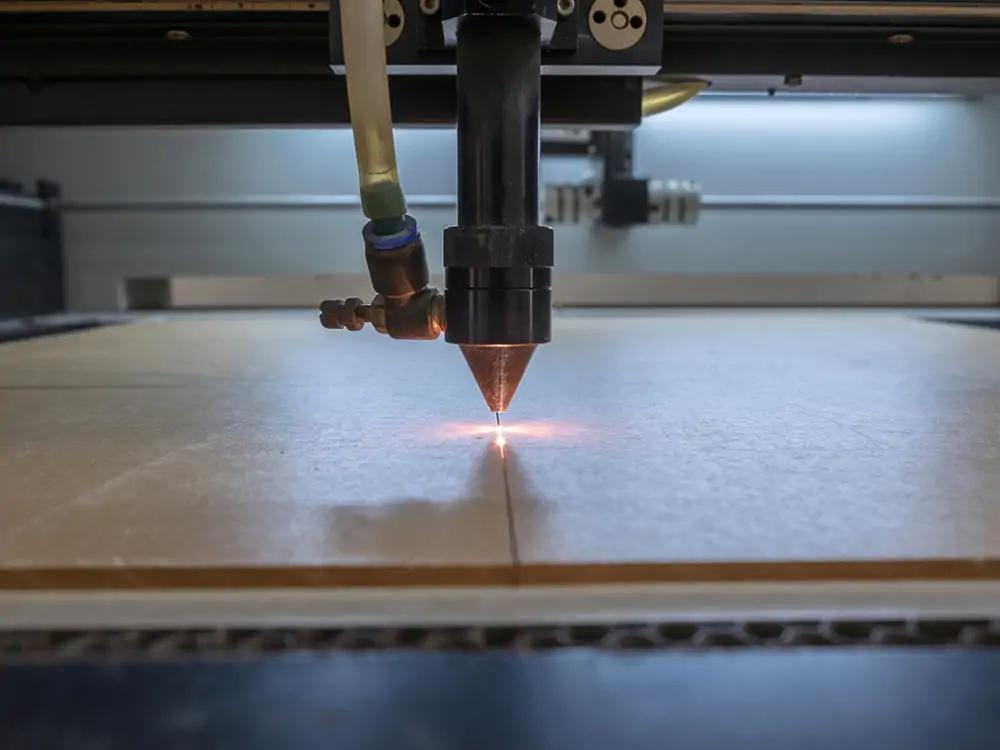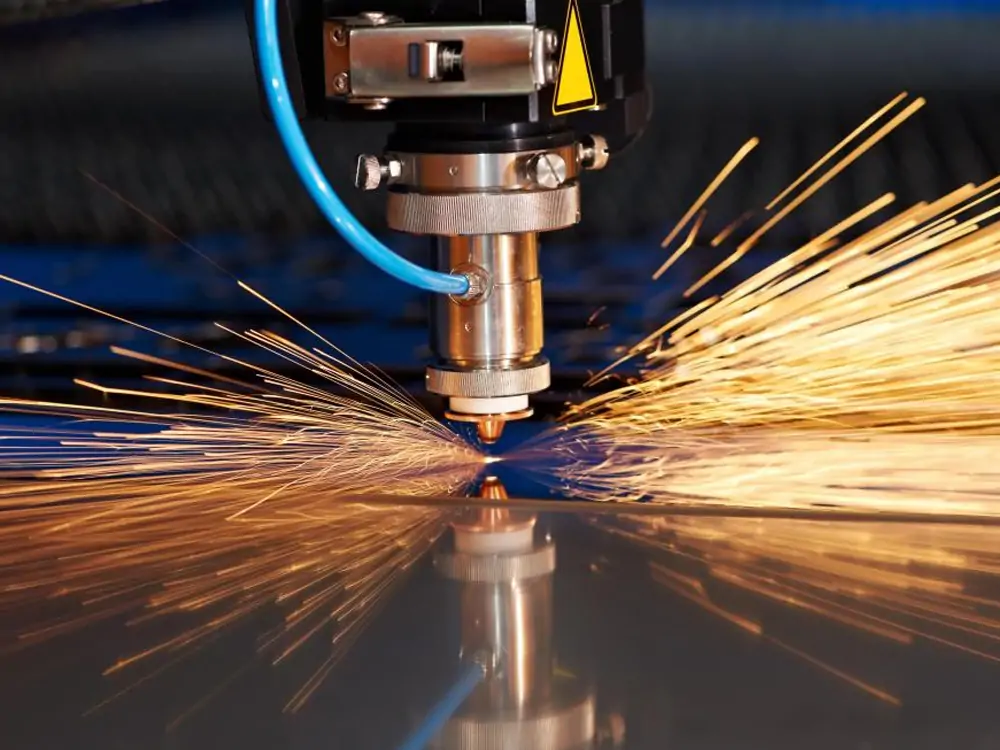Laser cutting machines have high commercial value and a wide range of applications. As a new tool, laser cutting equipment has been increasingly applied to various industries. The laser cutting process can also solve the problem of low efficiency of the traditional manual process. Generally speaking, laser cutting machines have a vast space for development.
We have met many customers, and most don’t know how laser cutting works. We have completed this article to let more people know about laser cutters. After reading this article, I hope you can understand the laser cutting process better.
How Does Laser Cutting Work
Laser cutting is one of the most advanced cutting processes in material processing. Laser-cut is realized by the high power density energy generated after laser focusing. By manually controlling the computer, the pulses discharge the laser. Output regulated and repeated high-frequency pulse laser to form a specific frequency beam and pulse width beam. The laser beam irradiates the workpiece, causing the material at the irradiated place to melt and vaporize rapidly. At the same time, the molten material is removed using a high-speed airflow coaxial with the beam. In this way, the laser cutting work is realized.

Classification of Laser Cutting
Laser cutting can be divided into three categories: laser vaporization, laser melting, and laser oxygen cutting. What are the working principles of these three laser-cut methods? What materials are they mainly used in?
Laser Vaporization Cutting
This laser-cut method uses a high-energy-density laser beam to heat the workpiece. The temperature rises rapidly, reaching the boiling point of the material in a short time. The material begins to vaporize, forming a vapor. The ejection velocity of these vapors is excellent. Simultaneously with the ejection of the steam, an incision is made in the material. Laser vaporization cutting requires a lot of power.
Laser vaporization cutting is mostly used for fragile and non-metal materials (such as paper, cloth, wood, plastic, rubber, etc.).
Laser Melting Cutting
During laser fusion cutting, the metal material is melted by laser heating. Non-oxidizing gases (Ar, He, N, etc.) are then ejected through a nozzle coaxial with the beam. Rely on the solid pressure of the gas to make the liquid metal discharge and form an incision. Laser fusion cutting does not require complete vaporization of the metal. It requires only 1/10 of the energy needed by vaporization cutting.
Laser melting is mainly used for cutting some materials that are not easily oxidized or active metals. Such as stainless steel, titanium, aluminum, and its alloys.
Laser Oxygen Cutting
The principle of laser oxygen cutting is similar to that of oxyacetylene cutting. It uses a laser as a preheating heat source and active gas such as oxygen as cutting gas. On the one hand, the ejected gas interacts with the cutting metal to undergo an oxidation reaction, releasing much oxidation heat. On the other hand, molten oxides and melts are blown out of the reaction zone, forming incisions in the metal. Since the oxidation reaction in the cutting process generates a lot of heat, the energy required for this process is only 1/2 of that for melting and cutting. And the cutting speed is far greater than the other two.
Laser oxygen cutting is mainly used for easily oxidized metal materials such as carbon steel, titanium steel, and heat-treated steel.

Pros and Cons of Laser Cutting
No craft is perfect. Compared with other cutting methods, laser cutting has enough advantages. Its main features are fast cutting speed and high quality. On the other hand, it also has certain flaws.
Pros of Laser Cutting
- Good Cutting Quality
Due to the small laser spot, high energy density, and fast cutting speed, laser cutting can obtain better cutting quality. Specifically, it can be manifested in the following aspects:
- The laser cutting incision is narrow, and the dimensional accuracy of the cut parts can reach ±0.05mm.
- The cutting surface is smooth and beautiful. The surface roughness is only tens of microns.
- After the material is laser cut, the width of the heat-affected zone is minimal. The properties of the material near the kerf are also barely affected.
- High Cutting Efficiency
Due to the transmission characteristics of the laser, the laser cutting machine is equipped with multiple CNC workbenches. The entire cutting process can be fully realized by numerical control. During operation, you only need to change the CNC program. It can be suitable for cutting parts of different shapes. Both two-dimensional cutting and three-dimensional cutting can be realized.
- Fast Cutting Speed
Use a laser with a power of 1200W to cut a 2mm thick low-carbon steel plate, and the cutting speed can reach 600cm/min. Cutting a 5mm thick polypropylene resin board, the cutting speed can be 1200cm/min. The material does not need to be clamped and fixed during laser cutting. It can not only save tooling and fixtures but also save auxiliary time for loading and unloading.
- Non-contact Cutting
There is no contact with the workpiece during laser cutting, and there is no tool wear. To process parts of different shapes, you only need to change the output parameters of the laser. The laser cutting process has low noise, slight vibration, and no pollution.
- Wide Variety of Cutting Materials
There are many types of laser cutting materials. These include metal, non-metal, metal-based, and non-metal-based composite materials, leather, wood, and fiber.
Cons of Laser Cutting
- Limited Material Thickness
Due to the limitation of laser power and equipment volume, laser cutting can only cut plates and pipes with medium and small thicknesses. Moreover, as the thickness of the workpiece increases, the cutting speed decreases significantly.
- High Cost
Laser cutting equipment costs are high, and the one-time investment is large.

Comparison of Different Cutting Methods
|
|
Slit (mm)
|
Out of shape
|
Precision
|
|
Laser cutting
|
very small (0.1-0.3)
|
very small
|
High (2.0mm)
|
|
Plasma Cutting
|
smaller
|
larger
|
High (1mm)
|
|
Water Cutting
|
larger
|
Small
|
High
|
Composition of Laser Cutting Machine
A professional laser cut machine usually consists of the following parts:
Laser
That is the laser generator. It is a device that emits laser energy through electro-optic conversion.
Cutting Head
It contains the nozzle, focusing lens, and focus tracking system software.
Light Transmission Part
It is a mirror. It is the orientation necessary for laser guidance.
CNC System
Control the machine tool to realize the movement of the X, Y, and Z axes. It also controls the output power of the laser.
Cooling System
It cools the cutting head’s laser and circulating cooling device. It can maintain the regular operation of the equipment and ensure stable beam delivery.
Stabilizer
It stabilizes the laser cutting machine’s power supply voltage to ensure the equipment’s smooth operation.
Air Compressor
Provide an air source device for the laser cutter during air cutting to ensure the pressure and flow required by the equipment.
Gas Tank
It contains a working material gas tank and an auxiliary gas tank for the laser cutter. It fills the chemical gas for laser fluctuation and provides additional gas for cutting the head.
Filter
They supply clean, dry gas to the laser generator and light channel. It can maintain the everyday work of the channel and reflector.
Dust Removal Equipment
The dust and smoke generated during production and processing are extracted and filtered.

Conclusion
Generally speaking, compared with other cutting methods, laser cutting has more obvious advantages. Different laser-cut methods are suitable for different materials. Through this post, you already have a particular understanding of how laser cutting works.
If you are considering a laser cutting machine, there are many factors to consider. First of all, we must consider the scope of production and processing materials of our own company. This way, the laser cut machine’s model, format, and quantity are determined. Laser cut machine applications involve mobile phones, computers, leather, clothing, furniture, and many other industries. Consult professional laser cutter manufacturers if you are unsure. We recommend the experienced HanTenCNC to you. They will give you professional answers.
